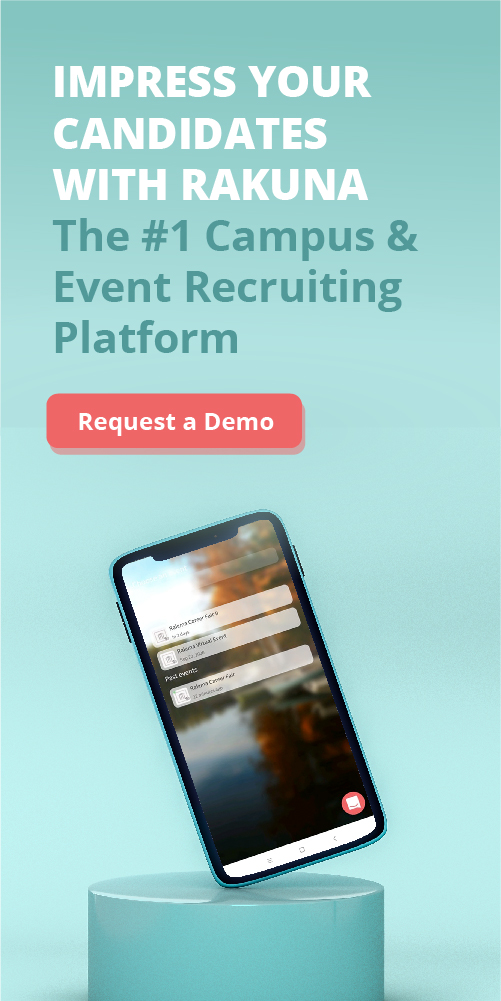Out of 929 businesses responding to Northstar Meetings Group’s latest PULSE Survey, 81% of respondents plan to hold or attend in-person events sometime in 2021. Even better, within that 81% of respondents, 59% aim for Q3 and Q4 2021.
The appearance of the Pandemic marks a time of change for everyone, both student candidates and recruiters alike. To better prepare for upcoming hiring seasons, let us go through some of the critical campus recruitment trends post COVID affecting the current recruitment landscape.
Want a refresh on Campus Recruiting? Visit our Campus Recruitment 101 blog which covers everything you need to know.
Hybrid Recruiting Enables Recruiters to Adapt

Our previous article shared a positive outlook regarding the campus recruiting space post-pandemic, and some of the inevitable changes recruiters are experiencing. One of them is the adoption of the Hybrid recruiting model – combining online & offline recruiting.
The recruiting trends we will be discussing today are the by-products of the Hybrid model. Serving as the catalyst for change, here is why recruiters are embracing the Hybrid model:
The Definition
The name says it all: The Hybrid model combines in-person campus recruiting activities like attending career fairs, hosting information sessions, and conducting face-to-face interviews, combined with virtual recruiting efforts such as hosting virtual events.
After the Pandemic, most recruiters would be eager to re-engage in in-person activities again, returning to tried and true recruiting processes of building and maintaining solid relationships. However, virtual recruiting is here to stay. Perks like the ability to overcome geographical limits, increasing hiring speed, and even halving the cost-to-hire draw companies to keep virtual recruiting long after the pandemic.
So, Why Should We Adopt Hybrid Models?
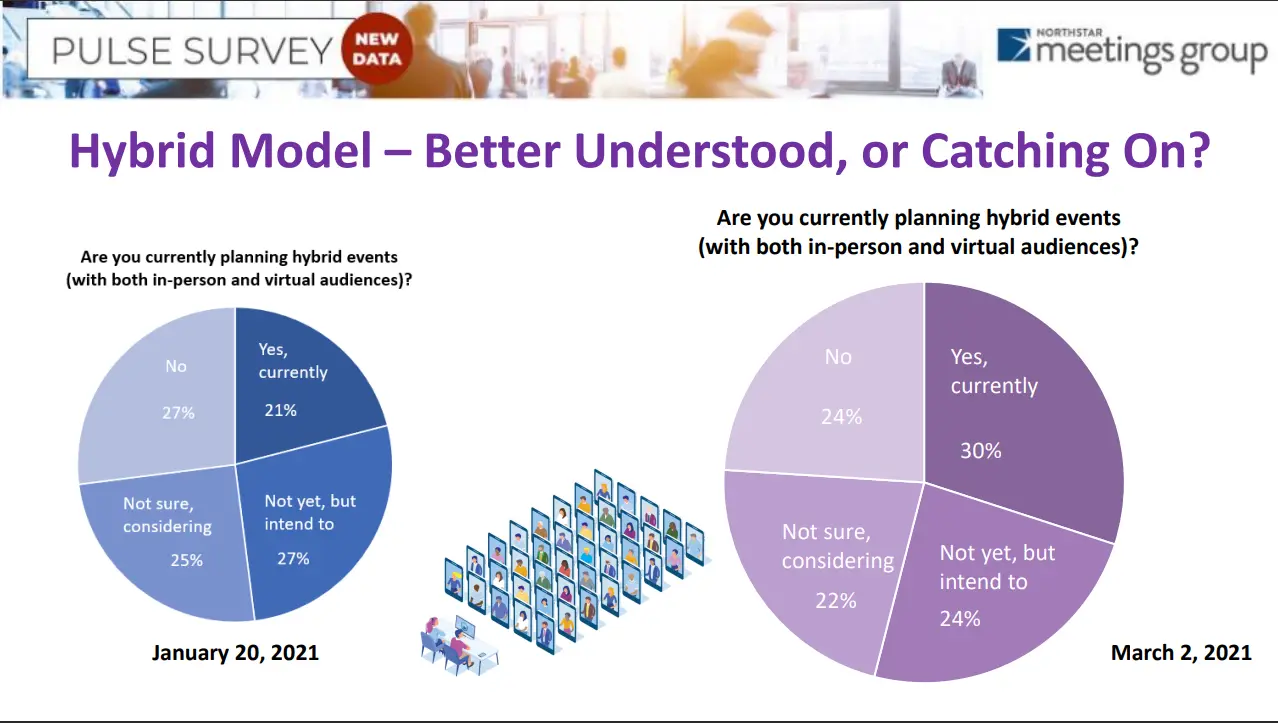
Source: [Northstar meeting group PULSE survey 2021](https://www.northstarmeetingsgroup.com/uploadedFiles/Northstar-PULSE-Survey-030321.pdf)
In PwC’s 2021 US Remote Work Survey, many respondents said they feel confused about whether to prepare to go back to in-person recruitment or double down on virtual activities.
It is normal to feel skeptical about a new work model, especially in the current recruitment landscape. If you are still wondering whether to give these hybrid recruiting models a chance, consider these benefits:
A time-saving investment: Even if you are not confident enough to commit to virtual recruiting as part of the hybrid model, the tools and software will still be helpful to your in-person recruiting team. Most advanced video interviews tools like HireVue will have an auto-scheduling feature integrated into their software.
Future-proofing your business: One thing the Pandemic has taught us is that the future still holds a lot of surprises for us. With how things are going worldwide, career fairs can steadily return to being held in-person. However, all it takes is another outbreak to push recruiters and candidates back to virtual platforms. Recruiting using a hybrid model means you and your team will be acquainted with both sides of the coin. Ultimately, your hiring team can react and adapt accordingly to the situation, thanks to the model’s flexibility and scalability.
Easing your recruiters back to the office, one task at a time: Going back to the US Remote Work Survey, PwC discovered that the expectation of going back to working in the office between the employees and employers is quite different.
According to PwC, 61% of the surveyed employees expect to spend only half of their time working at the office. Much higher than the employers have anticipated.
PwC’s 2021 US Remote Work Survey
Depending on how you design your recruiting model, recruiters have the option to operate both online and on the field. For example, a parent will find it more challenging to return to office work due to no one taking care of their child.
With the layered hybrid approach, the recruiter can sign up for processes that use virtual recruiting. Due to the model being applied on a hiring funnel with different stages, the recruiter can know precisely when the in-person activities, such as a career fair, will take place and plan their return accordingly.
Current Campus Recruitment Trends Post COVID
With many recruiters steadily embracing Hybrid models, the campus recruitment landscape is experiencing the rise of new hiring trends and even the evolution of old ones. Let us see what surprises the post-pandemic world has in store for us.
Recruiters Are Expanding From Traditional Talent Pools

This is a very positive campus recruiting trend for both recruiters and candidates. Hiring teams are now targeting more diversified talent pools with a focus on personal skills and culture fit.
Before the Pandemic, a hiring team must consider the school’s location where they are conducting the campaign. Branching out and scouting for new schools means potentially stretching human resources thin and incurring extra cost .
For your candidates, living further away from the office was an actual disadvantage since the concept of working from home was still not widely adopted pre-COVID-19. In this period, a hiring team could miss out on an entire pool of talented candidates simply because they live too far from the office.
With the Hybrid recruiting model, the barrier is coming down. Recruiters can now expand their search for entry-level candidates past schools in the local areas with less hassle and cost. No more travel fees or booth fees; the main tools for virtual recruiting teams will now be laptops, microphones, and webcams.
Not being constrained by locations, recruiters no longer need to source around their areas and instead come to where the talent is. Subsequently, candidates no longer need to look for jobs that are near them. Expect students and entry-level candidates to use the internet to actively find job opportunities and research companies.
Employer Branding Will Need an Overhaul After the Pandemic

Being stuck at home during lockdown has reinforced the habit of many Gen Z students searching for information on the internet. So, if your business still has little online presence, now is the time to have one.
Every recruiter knows that most Gen Zers are highly tech-savvy individuals, connected and empowered by the Internet. As a result, they are more informed and interested in topics like racial equality, work-life balance, etc. A beautiful office is less likely to draw Gen Zers’ attention than employees’ testimony and live footage of what it’s like working for your company. Keep this in mind when designing your post-pandemic branding, whether it’s a virtual information session or virtual career fairs
If you need help designing your brand to fit this campus recruiting trend, consider employing an ATS. Most applicant tracking systems allow users to create dynamic and unique career pages to reel in candidates. A good ATS solution makes the process seamless and hassle-free.
Take TeamTailor ATS, for example. Teamtailor is a solution created by people who have experienced what working with unoptimized software feels like. The ATS is not encumbered by unnecessary features and possesses a very smooth learning curve.
Creating and managing a career page is done by dragging and dropping “content cubes” that you can edit. You can choose from dozens of beautiful templates or create one from scratch. All require next to 0 coding skills. Intrigued? Visit us to learn more about this intuitive ATS!
Students require more comprehensive job and career mapping
The COVID-19 pandemic has put both undergraduate and graduate students in a very vulnerable position. In a 2021 research paper, the Pew Research Center discovered that by October 2020, only 69% of adults who graduated college in the previous spring with a bachelor’s degree or higher were employed. Significantly lower than last previous year’s report at the same time (78% of adults)
For the immediate period right after the pandemic, holding down a job can still be very challenging. A student will have to adapt to working from home and in the office or postpone their internship if another outbreak occurs. Like any employee, campus candidates yearn for a sense of stability when they decide to work for you.
A common request a student might ask recruiters is to be shown a detailed schedule or map of their internship. How long will I be working in this position? What will I get to learn, the chance of being promoted to a full-time job, and what will happen in the event of another outbreak?
Any hiring team should prepare a detailed map or breakdown chart of the position before engaging candidates and be ready for questions regarding their future in your company.
Recruiters Become Less Reliant on GPA Score
Only 56,6 % of respondents in NACE’s Job Outlook Report 2021 use GPA scores to scan graduates for job recruitment.
NACE’s Job Outlook Report 2021 – Spring Update
What could have spurred this campus recruiting trend?
The Pandemic has changed how they look at a candidate. Instead of relying on academic records, managers want to see more tangible proof highlighting the candidate’s trainability or job and culture fit. Soft skills and previous job experiences are being scanned in as much detail as ever to find suitable employees.
NACE once again provided us with data that signified the rise of this recruiting trend. In a 2021 post from NACE titled “Internship Experience The Top Differentiator When Choosing Between Otherwise Equal Job Candidates,” previous experiences like prior internships with the same company or industry hold the most significant sway over hiring decisions. In contrast, the influence of GPA scores ranked 5th.
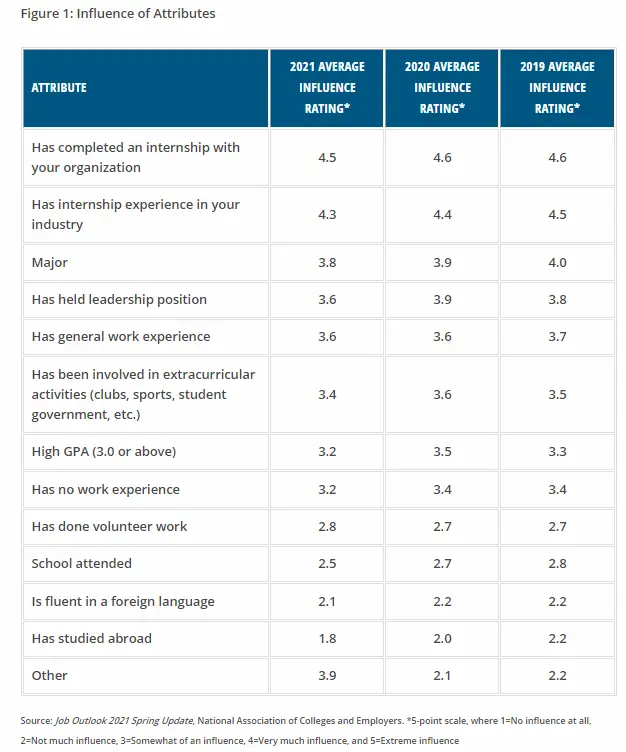
Source: Internship Experience The Top Differentiator When Choosing Between Otherwise Equal Job Candidates – Kevin Gray/NACE – April 19, 2021
If your recruiters are still making hiring decisions based on pre-pandemic requirements and priorities, consider overhauling them according to your employer’s needs in the recovery phase and current recruiting trends. If your team struggles to decide on new priorities to recruit student candidates, check out how NACE’s members are doing it. Below is a ranking of the most common attributes NACE members are looking for in a resume!
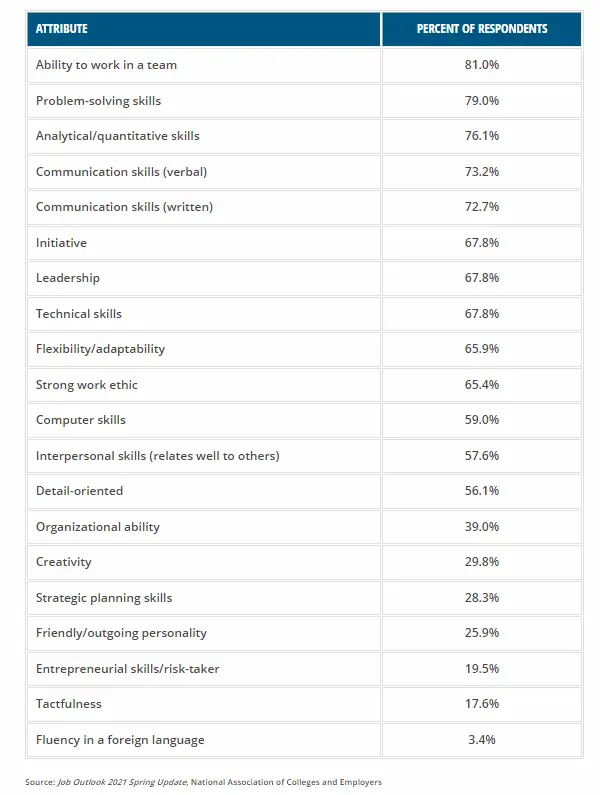
Source: The Attribute Employers Seek On Student’s Resume – Kevin Gray/NACE – April 19, 2021
A Shift in Candidates’ Expectations
Being accustomed to the work-from-home model and the naturally more pleasant environment of the home office is shaping how candidates view this practice. The “WFH” model gives its practitioners more autonomy than the traditional office model. Students are so used to designing and adapting the work environment to their liking, which will be more difficult when it is time to return to the office. Asking Gen Zers to sacrifice their autonomy is getting increasingly difficult now that they have experienced working from home.
Instead of getting your student candidates to abandon their WFH model, companies should find more effective ways to perform tasks in a WFH environment. Returning to the PwC’s 2021 US Remote Work Survey:
Out of 133 executives surveyed, 52% said the average employee productivity has increased by at least 40%!
PwC’s 2021 US Remote Work Survey
Another side-effect of the WFH model is that candidates expect employers to provide a more compelling employee experience alongside the standard monetary compensation and benefits. Physical benefits like sleeping spots and snack bars hold little value to practitioners of the WFH model.
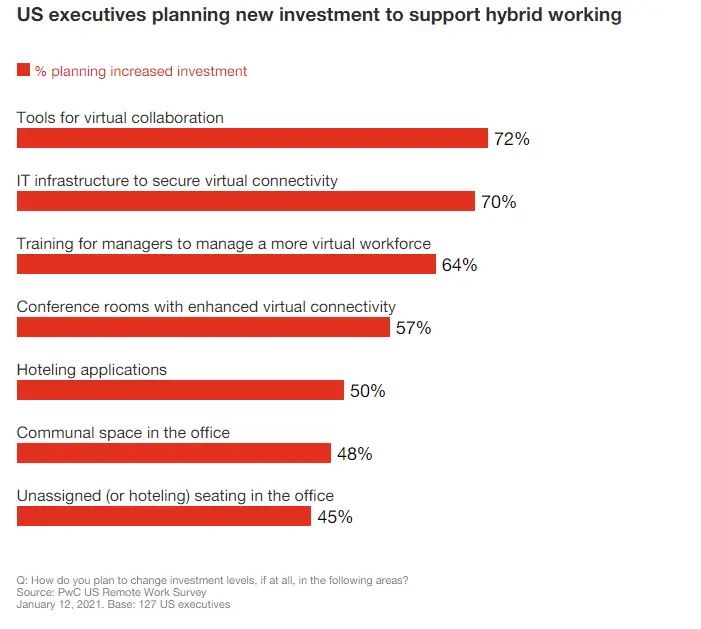
Source: PwC’s 2021 US Remote Work Survey
Businesses can enable better communication across virtual channels to accommodate WFH as part of the Hybrid work model. Up to 72% of executives who responded to the PwC survey said they would invest in tools to facilitate better virtual cooperation this year.
Recruiters and Employers Are Playing a Bigger Role In Employees’ Experience

Recruiters’ Role in Diversity and Inclusion (D&I)
In the post-pandemic period campus recruiting environment, many executives still believe that managing D&I elements is the responsibility of the HR department. In a Forbes Insights survey of 321 executives in charge of D&I in their company, 65% said the responsibility of implementing policies and programs belongs to HR. However, Gen Z candidates might change this preconception very soon.
Events that happened alongside the Pandemic, like George Floyd’s killing, have sparked a worldwide movement and reignited the focus on diversity and inclusion in workspaces. A 2020 GlassDoor survey on D&I discovered that at least 3 out of 4 participants consider D&I an essential factor when deciding on a job offer.
As companies are steadily ramping up their D&I efforts, recruiters now have a role in ensuring a positive D&I environment. As one of the first company representatives that the candidates will meet, recruiters can weed out bias in the hiring process.
On the other hand, candidates who show concerns about D&I topics are also more likely to bring it up with recruiters instead of waiting for a demonstration from HR once they have been accepted.
Diversity and inclusion in recruiting processes is not a new concept. However, between the increasing use of the internet by an informed generation and talent availability thanks to the Hybrid work model, managers stand to benefit from investment in tools and efforts to hire a diverse team.
Employers to Provide a ‘Social Security Net’ Post-Pandemic
The pandemic has pushed thousands of individuals into a vulnerable state, both physically and mentally. Although companies and global governments have put forward multiple relief plans, the amount of affected individuals is simply too large. It is not difficult to find cases where funds and resources failed to reach vulnerable populations due to negligence, corruption, or other unforeseeable factors.
Having witnessed or even experienced this vulnerable state, Gen Z candidates expect more support from their employers. The International Labour Organization has issued a Framework to support employees during and after the pandemic. Support can range from monetary backing, increased sick leaves, child-care support, or even mental counseling:
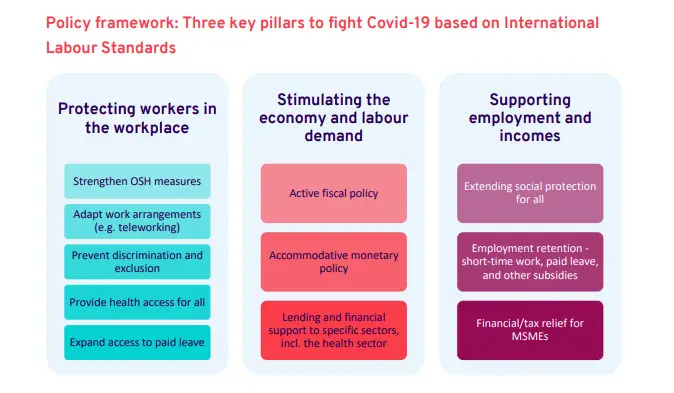
Source: COVID-19 and the world of work: Impact and policy responses – International Labour Organization 2020
Savvy recruiters should always be up-to-date with the latest support policies from their employers. Knowing your candidates’ desires is critical in getting them interested in the position and company. When doing a competitor analysis, don’t forget to research their support policies and compare them with yours.
To Conclude
We hope through these campus recruiting trends, recruiters and hiring managers alike will be ready for the upcoming recruiting season. Though the world has yet to fully recover from this terrible pandemic, the recruiting trends mentioned above are testaments to people’s adaptability and resilience despite hardship.
If you need a starting point to prepare for the upcoming recruiting season, consider checking out these quick tips on post-pandemic preparation.
Vector images in this post provided by: FreePik

